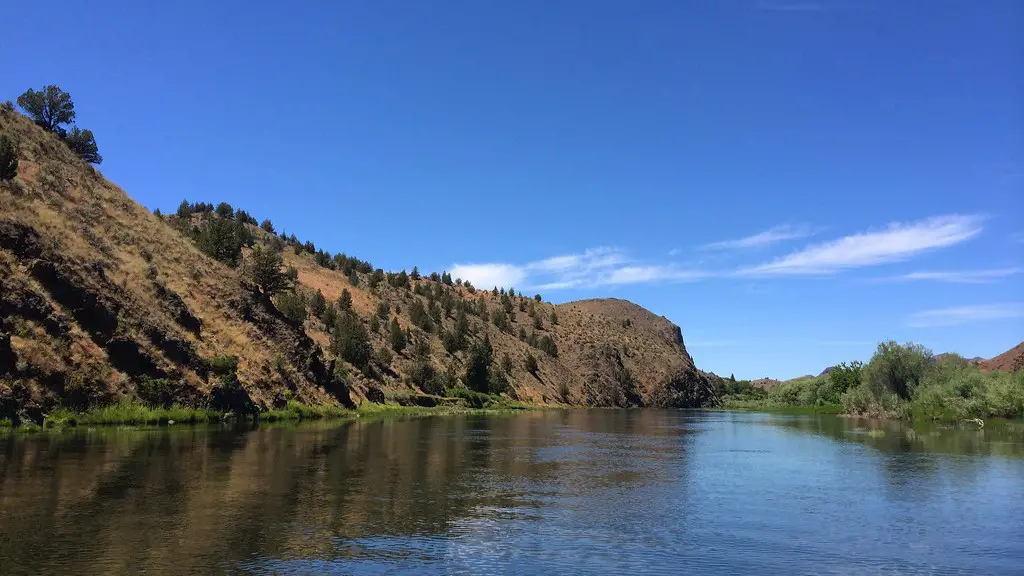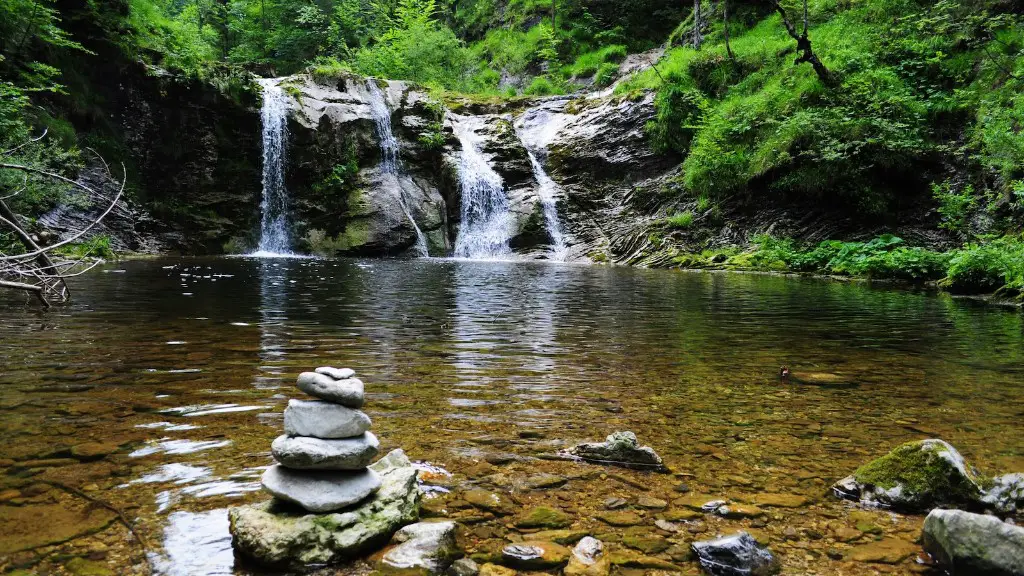Freshwater
The Mississippi River is an important natural resource for its surrounding states, providing many forms of freshwater. The watershed of the Mississippi is the world’s third largest, covering 30 states and two Canadian provinces and draining an area of 1.2 million square miles. Its average water flow of about 2.2 million square feet per second is the second highest in North America and its drainage basin has a population of more than 35 million. It also serves as a habitat for many species of fish and wildlife.
The river provides fresh drinking water for many of the cities and towns along its banks, including New Orleans, Minneapolis, St. Louis, and Memphis. Its water is also used for irrigation, flood control, energy, navigation, recreational activities, and other industrial and commercial purposes.
The quality of the river’s water is scrutinized since it accumulates pollutants transported by its own vast watershed as well as from sources in areas not associated with the Mississippi. This has been an ongoing source of concern among regulators, since contamination of the river’s freshwater could have far-reaching effects.
Timber
The Mississippi River is a major source of timber, providing a great deal of the lumber harvested throughout the United States. Much of this timber is supplied by the forests along the river, which are home to numerous species of trees and other plants. These forests serve as a major habitat for many species of wildlife, providing shelter and food for many species of birds, mammals, amphibians, and reptiles.
The forests along the Mississippi are also home to an array of other products and resources, such as medicines, nuts, and berries, which are harvested and used both locally and commercially in various states along the river. The harvesting of these resources, as well as the logging of timber, has become an increasingly important industry for the economies of many states along the Mississippi.
Despite the growing importance of the harvesting of timber and other resources from the forests along the Mississippi, the sustainability of these resources is a major concern for environmentalists and policy makers. As the forests along the Mississippi are increasingly threatened by climate change, pollution, and human development, it is important to address the long-term management of these resources.
Mineral Resources
The Mississippi River is also home to a variety of mineral resources, including gravel, sand, natural gas, coal, and other forms of energy. Much of this mineral wealth is located in the sedimentary rock layers along the banks of the river, in which various minerals are found. These minerals are mined and used in the production of various commercial and industrial products, such as asphalt and concrete.
The hydraulic energy created by the Mississippi River is also a major form of energy used in the United States. The river’s energy is used to generate electricity and to operate many industry and agricultural activities, such as mills and grain elevators. The river’s energy is also used in the transportation of goods and materials, such as coal and oil, from one destination to another.
The mineral resources of the Mississippi are important to the economy of the region, providing a great deal of the raw material for industrial production. However, the continued extraction of these resources has been met with much criticism from environmental groups, who argue that such activity has a detrimental impact on the local ecosystems and wildlife.
Aquatic Species
The Mississippi River is home to an abundance of aquatic species, from fish and other aquatic animals to invertebrates, birds, and amphibians. A great deal of this species diversity is threatened by development and pollution, with many endangered species now listed in the Mississippi River. In order to protect these species and the entire ecosystem of the river, many conservation efforts have been put in place by state and federal agencies.
The abundance of aquatic species in the Mississippi is a major source of food for a variety of predators, ranging from large mammals such as bears and mountain lions to birds such as falcons and owls. These predators often hunt near the water’s edge, creating a dynamic ecosystem in which these species compete for food and resources. The diversity of species found in the river also provides a major source of recreation, such as fishing and boating, which draw large numbers of tourists to the area each year.
These species of aquatic wildlife are also an important source of genetic variations that help maintain the ecology of the river and its surrounding areas. As some species are becoming increasingly endangered due to factors such as climate change and human incursions, it is becoming increasingly important to preserve these species to preserve the natural environment of the river.
The Mississippi River also serves as a major commercial navigational route for cargo vessels, tugboats, and barges. Its winding pathways are ideal for transporting goods from one end of the country to the other, with numerous ports located at strategic points along the river. This provides a major source of goods for many cities along the river and its surrounding areas, as well as for places further afield.
The navigational capabilities of the Mississippi are further enhanced by the numerous tributaries that lead into the river, providing access to even more goods and services. These tributaries also provide access to inland flooding and irrigation, making them essential for the farming of crops and other activities.
The navigational capabilities of the Mississippi are further enhanced by the creation of state and federal channels and waterways, providing economic corridors for ships, barges, and other vessels. Such channels form important links between destinations along the river, which is why they are essential for commercial navigation and economic development. The navigation of the Mississippi is also a major form of recreation, with many people participating in activities such as fishing, boating, and sightseeing.
Power Generation
The Mississippi River is home to numerous hydroelectric dams, generating electrical and mechanical power for cities, towns, and communities along the river. These hydroelectric dams provide an important source of renewable energy for the communities along the Mississippi and its surrounding regions, supplying power for public and private needs.
The hydroelectric dams of the Mississippi are also essential for flood control, assisting in the regulation of flooding throughout the entire region. Without these dams, the numerous rivers and tributaries of the Mississippi would be subject to dangerous and damaging floods, which can cause massive damage to lives and property in the area.
The hydroelectric power generated by the Mississippi is also an important source of power for the industrial sector of the region, providing a renewable and clean energy source for numerous heavy industries along the river. These industries rely on the electricity and mechanical power supplied by the dams, which is why it is important to ensure their proper maintenance and operation.
Sustainable Use and Conservation
The natural resources of the Mississippi River are an important part of the economy and ecology of the region, providing numerous benefits to communities throughout the United States and Canada. The continued use and exploitation of these resources must take place in a sustainable manner, with conservation and preservation efforts in place to protect and preserve the river’s wildlife and ecosystems.
With numerous endangered species now listed along the river, it is essential to ensure the continued preservation and protection of these species and their habitats. Numerous conservation efforts are underway throughout the river’s watershed, in hopes of preserving the biodiversity of this region and sustaining the various ecosystem services provided by the river.
The human population of the Mississippi River’s watershed continues to increase, with many communities now dependent on the river for their livelihoods. The use and exploitation of the river’s natural resources must be done in a manner that ensures the sustainability of the river and its resources for future generations.
Climate Concerns
The health and future of the Mississippi River are now threatened by climate change and its associated effects, such as sea level rise, extreme weather, and drought. All of these factors will have a major impact on the river’s freshwater, timber, mineral resources, aquatic species, and its navigational capabilities.
It is essential to address the issue of climate change and its associated effects on the region, in order to protect the Mississippi River and other rivers within the watershed. This can be done through an increased focus on conservation and sustainability, with stricter regulations and laws in place to mitigate the damage done to the local ecosystems and wildlife.
Changes in local and regional policies should also be made to ensure the long-term health of the Mississippi River and its surrounding environment. This could involve investment in alternative energy sources and the implementation of more energy efficient practices in the industrial, agricultural, and transportation sectors.
Economic Opportunities
The Mississippi River is a major source of economic prosperity for many states along its banks, providing opportunities for numerous industries and businesses. The timber, mineral resources, and navigational capabilities of the river have provided numerous economic opportunities for communities throughout the United States and Canada.
The recreational activities of the river, such as fishing and boating, have also become an increasingly important industry for the economies of many towns and cities along the river. These recreational activities have helped to create an upsurge in tourism, providing an important source of income for many locals.
The economic opportunities provided by the Mississippi River are now threatened by the ongoing issues of climate change and pollution, both of which have the potential to severely damage the river’s resources. It is therefore essential to maintain the health and sustainability of the land, waters, and ecosystems of the river, in order to ensure a prosperous future for the region.
Urbanization
The development of towns and cities along the Mississippi River has had an increasingly negative effect on the river and its environment. Urbanization has caused a decrease in the flow and quality of the river’s freshwater, as well as the displacement of many species of wildlife from their habitats.
The urbanization of the Mississippi has also led to the increased pollution of the river’s waters, with many pollutants now entering the river from cities and towns along its banks. This has had a detrimental effect on the river’s ecosystems, with numerous species now endangered or threatened.
The urbanization of the Mississippi must be addressed in order to ensure the long-term health of the river and its surrounding ecosystems. Regulations and laws must be implemented to ensure that future development around the river is done in a sustainable manner, protecting its natural resources and the wildlife that depend on them.





